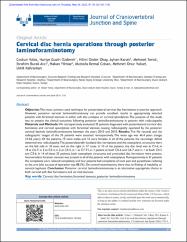Cervical disc hernia operations through posterior laminoforaminotomy

View/
Access
info:eu-repo/semantics/openAccessDate
2016Author
Yolaş, CoşkunÖzdemir, Nuriye Güzin
Okay, Hilmi Önder
Kanat, Ayhan
Şenol, Mehmet
Atçı, İbrahim Burak
Yılmaz, Hakan
Çoban, Mustafa Kemal
Yüksel, Mehmet Onur
Kahraman, Ümit
Metadata
Show full item recordCitation
Yolas, C., Ozdemir, N. G., Okay, H. O., Kanat, A., Senol, M., Atci, I. B., Yilmaz, H., Coban, M. K., Yuksel, M. O., & Kahraman, U. (2016). Cervical disc hernia operations through posterior laminoforaminotomy. Journal of craniovertebral junction & spine, 7(2), 91–95. https://doi.org/10.4103/0974-8237.181854Abstract
Objective: the most common used technique for posterolateral cervical disc herniations is anterior approach. However, posterior cervical laminotoforaminomy can provide excellent results in appropriately selected patients with foraminal stenosis in either soft disc prolapse or cervical spondylosis. the purpose of this study was to present the clinical outcomes following posterior laminoforaminotomy in patients with radiculopathy. Materials and Methods: We retrospectively evaluated 35 patients diagnosed with posterolateral cervical disc herniation and cervical spondylosis with foraminal stenosis causing radiculopathy operated by the posterior cervical keyhole laminoforaminotomy between the years 2010 and 2015. Results: the file records and the radiographic images of the 35 patients were assessed retrospectively. the mean age was 46.4 years (range: 34-66 years). of the patients, 19 were males and 16 were females. in all of the patients, the neurologic deficit observed was radiculopathy. the posterolaterally localized disc herniations and the osteophytic structures were on the left side in 18 cases and on the right in 17 cases. in 10 of the patients, the disc level was at C5-6, in 18 at C6-7, in 2 at C3-4, in 2 at C4-5, in 1 at C7-T1, in 1 patient at both C5-6 and C6-7, and in 1 at both C4-5 and C5-6. in 14 of these 35 patients, both osteophytic structures and protruded disc herniation were present. Intervertebral foramen stenosis was present in all of the patients with osteophytes. Postoperatively, in 31 patients the complaints were relieved completely and four patients had complaints of neck pain and paresthesia radiating to the arm (the success of operation was 88.5%). on control examinations, there was no finding of instability or cervical kyphosis. Conclusion: Posterior cervical laminoforaminotomy is an alternative appropriate choice in both cervical soft disc herniations and cervical stenosis.

















